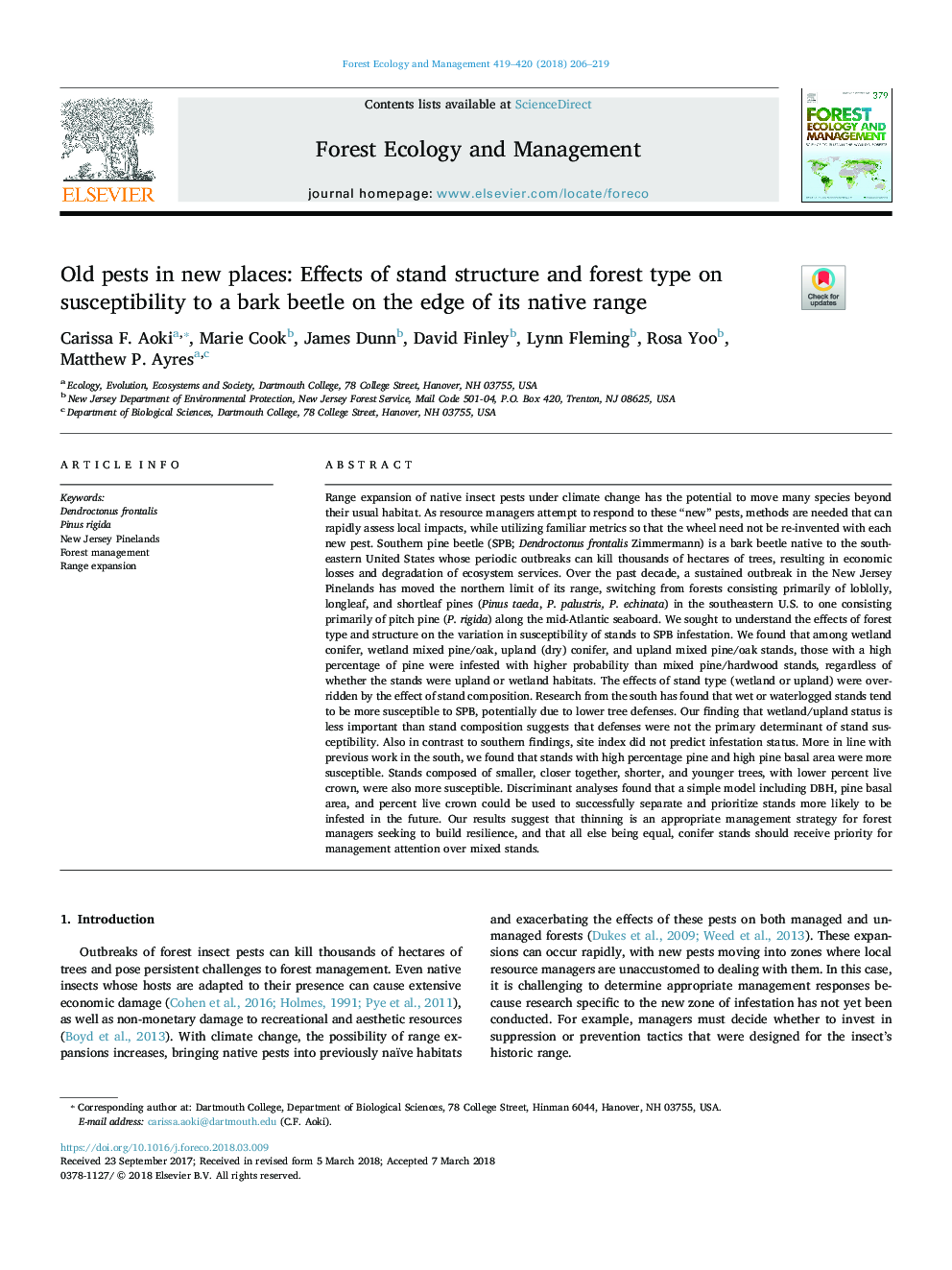| کد مقاله | کد نشریه | سال انتشار | مقاله انگلیسی | نسخه تمام متن |
|---|---|---|---|---|
| 6541719 | 1421340 | 2018 | 14 صفحه PDF | دانلود رایگان |
عنوان انگلیسی مقاله ISI
Old pests in new places: Effects of stand structure and forest type on susceptibility to a bark beetle on the edge of its native range
ترجمه فارسی عنوان
آفات قدیمی در مکان های جدید: اثرات ساختار و ساختار سازه و نوع جنگل بر حساسیت به سوسک پوست در لبه دامنه بومی آن
دانلود مقاله + سفارش ترجمه
دانلود مقاله ISI انگلیسی
رایگان برای ایرانیان
کلمات کلیدی
موضوعات مرتبط
علوم زیستی و بیوفناوری
علوم کشاورزی و بیولوژیک
بوم شناسی، تکامل، رفتار و سامانه شناسی
چکیده انگلیسی
Range expansion of native insect pests under climate change has the potential to move many species beyond their usual habitat. As resource managers attempt to respond to these “new” pests, methods are needed that can rapidly assess local impacts, while utilizing familiar metrics so that the wheel need not be re-invented with each new pest. Southern pine beetle (SPB; Dendroctonus frontalis Zimmermann) is a bark beetle native to the southeastern United States whose periodic outbreaks can kill thousands of hectares of trees, resulting in economic losses and degradation of ecosystem services. Over the past decade, a sustained outbreak in the New Jersey Pinelands has moved the northern limit of its range, switching from forests consisting primarily of loblolly, longleaf, and shortleaf pines (Pinus taeda, P. palustris, P. echinata) in the southeastern U.S. to one consisting primarily of pitch pine (P. rigida) along the mid-Atlantic seaboard. We sought to understand the effects of forest type and structure on the variation in susceptibility of stands to SPB infestation. We found that among wetland conifer, wetland mixed pine/oak, upland (dry) conifer, and upland mixed pine/oak stands, those with a high percentage of pine were infested with higher probability than mixed pine/hardwood stands, regardless of whether the stands were upland or wetland habitats. The effects of stand type (wetland or upland) were overridden by the effect of stand composition. Research from the south has found that wet or waterlogged stands tend to be more susceptible to SPB, potentially due to lower tree defenses. Our finding that wetland/upland status is less important than stand composition suggests that defenses were not the primary determinant of stand susceptibility. Also in contrast to southern findings, site index did not predict infestation status. More in line with previous work in the south, we found that stands with high percentage pine and high pine basal area were more susceptible. Stands composed of smaller, closer together, shorter, and younger trees, with lower percent live crown, were also more susceptible. Discriminant analyses found that a simple model including DBH, pine basal area, and percent live crown could be used to successfully separate and prioritize stands more likely to be infested in the future. Our results suggest that thinning is an appropriate management strategy for forest managers seeking to build resilience, and that all else being equal, conifer stands should receive priority for management attention over mixed stands.
ناشر
Database: Elsevier - ScienceDirect (ساینس دایرکت)
Journal: Forest Ecology and Management - Volumes 419â420, 1 July 2018, Pages 206-219
Journal: Forest Ecology and Management - Volumes 419â420, 1 July 2018, Pages 206-219
نویسندگان
Carissa F. Aoki, Marie Cook, James Dunn, David Finley, Lynn Fleming, Rosa Yoo, Matthew P. Ayres,
